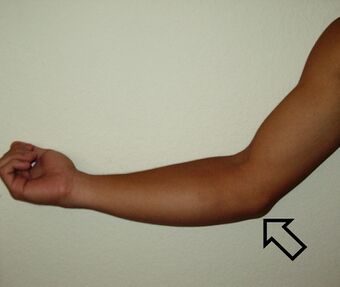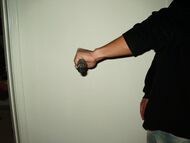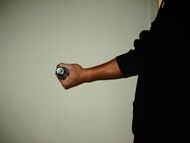Medicine:Ulnar collateral ligament injury of the elbow
| Ulnar collateral ligament injury of the elbow | |
|---|---|
 | |
| Location of UCL injury | |
| Specialty | Orthopedic |
Ulnar collateral ligament injuries can occur during certain activities such as overhead baseball pitching. Acute or chronic disruption of the ulnar collateral ligament result in medial elbow pain, valgus instability, and impaired throwing performance. There are both non-surgical and surgical treatment options.[1]
Signs and symptoms
Pain along the inside of the elbow is the main symptom of this condition. Throwing athletes report it occurs most often during the acceleration phase of throwing. The injury is often associated with an experience of a sharp “pop” in the elbow, followed by pain during a single throw.[2] In addition, swelling and bruising of the elbow, loss of elbow range of motion, and a sudden decrease in throwing velocity are all common symptoms of a UCL injury. If the injury is less severe, pain can alleviate with complete rest.[3]
Causes
The UCL stabilizes the elbow from being abducted during a throwing motion. If intense or repeated bouts of valgus stress occur on the UCL, injury may occur. Damage to the UCL is common among baseball pitchers and javelin throwers because the throwing motion is similar. Physicians believe repetitive movements, especially pitching in baseball, cause UCL injuries. Furthermore, physicians have stated that if an adolescent throws over 85 throws for 8 months or more in a year, or throws when exhausted, the adolescent has a significantly higher risk of UCL injury.[4]
Gridiron football, racquet sports, ice hockey and water polo players have also been treated for damage to the UCL.[5][6] Specific overhead movements like those that occur during baseball pitching, tennis serving or volleyball spiking increase the risk of UCL injury.[7] During the cocking phase of pitching, the shoulder is horizontally abducted, externally rotated and the elbow is flexed. There is slight stress on the UCL in this position but it increases when the shoulder is further externally rotated in a throw. The greater the stress the more the UCL is stretched causing strain. During the overhead throwing motion, valgus stress on the medial elbow occurs during arm cocking and acceleration. The initiation of valgus stress occurs at the conclusion of the arm-cocking phase. In the transitional moment from arm cocking to arm acceleration, the shoulder vigorously rotates internally, the forearm is in near full supination, and the elbow flexes from 90° to approximately 125°. From late cocking to ball release, the elbow rapidly extends from approximately 125° to 25° at ball release.[8] This causes extreme valgus stress and tensile strain on the UCL.
Injuries to the UCL may result from poor throwing mechanics, overuse, high throwing velocities, and throwing certain types of pitches, such as curveballs.[citation needed] Poor mechanics along with high repetition of these overhead movements can cause irritation, microtears or ruptures of the UCL. Kinetic chain dysfunction due to poor lower extremity strength, core strength and stability can be associated with UCL injuries, as well as capsular stiffness in glenohumeral internal rotation deficit (GIRD), and scapular dyskinesis.[9][10] Injuries to the UCL in baseball players are rarely due to one-time, traumatic events. Rather, they more often occur due to small chronic strains and tears accumulating over time.[citation needed]
Anatomy
The ulnar collateral ligament (UCL, also known as medial collateral ligament) is located on the medial side of the elbow. The UCL complex comprises three ligaments: the anterior oblique, posterior oblique and transverse ligaments.[11] The anterior oblique ligament (AOL) attaches from the undersurface of the medial epicondyle to the medial ulnar surface slightly below the coronoid process.[12] It is the sturdiest of the three sections within the UCL. The AOL acts as the primary restraint against valgus stress at the elbow during flexion and extension. The posterior oblique originates at the medial epicondyle and inserts along the mid-portion of the medial semilunar notch.[11] It applies more stability against valgus stress when the elbow is flexed rather than extended. The transverse ligament connects to the inferior medial coronoid process of the ulna to the medial tip of the olecranon.[11] Since it is connected to the same bone and not across the elbow joint, the transverse ligament has no contribution to the joint’s stability.
Diagnosis
In most cases, a physician will diagnose an ulnar collateral ligament injury using a patient’s medical history and a physical examination that includes a valgus stress test. The valgus stress test is performed on both arms and a positive test is indicated by pain on the affected arm that is not present on the uninvolved side.[13][14] Physicians often use imaging techniques such as ultrasound, x-rays and magnetic resonance imaging or arthroscopic surgery to aid with making a proper diagnosis.[citation needed]
Classification
A slow and chronic deterioration of the ulnar collateral ligament can be due to repetitive stress acting on the ulna. At first, pain can be bearable and can worsen to an extent where it can terminate an athlete’s career. The repetitive stress placed on the ulna causes microtears in the ligament resulting in the loss of structural integrity over time.[15]
The acute rupture is less common compared to the slow deterioration injury. The acute rupture occurs in collisions when the elbow is in flexion such as that in a wrestling match or a tackle in football. The ulnar collateral ligament distributes over fifty percent of the medial support of the elbow.[16][17] This can result in an UCL injury or a dislocated elbow causing severe damage to the elbow and the radioulnar joints.
Treatments
UCL injuries may or may not require surgery. Non-surgical treatment will primarily focus on strengthening the elbow joint to regain strength and stability.[18] First a course of RICE (Rest, ice, compression, elevation) is typically coupled with NSAIDS (Non-steroidal anti-inflammatory drugs) to help alleviate pain and swelling. When the swelling has subsided, individual exercises or physical therapy may be prescribed to strengthen muscles around the elbow joint to compensate for tearing in the UCL.[18] These may include biceps curls (non resistance and resistance), pronating and supinating the forearm, and grip strengthening exercises, performed with low resistance and moderate repetitions no more than three times a week.[19]
Surgical treatment may help restore the ability to perform the overhand throwing motions most commonly associated with UCL injuries. The reconstructive surgery, generally known as Tommy John surgery, was first performed by Dr. Frank Jobe in 1974 and has been modified several times since then.[20][21] The surgery involves an autograft of the palmaris longus tendon (mostly considered an accessory tendon) or an allograft of tissue from a cadaver or donor. The replacement tendon is attached by drilling holes in the medial epicondyle of the humerus and the sublime tubercle of the ulna and lacing the tendon through them in a figure eight.[18][5]
The patient may begin physical therapy shortly after. It usually takes 12–15 months after the surgery for standard rehabilitation because a tendon needs time to convert into a ligament.[22] Rehabilitation following UCL injuries or surgery should follow a sequential and progressive multi-phased approach that involves a gradual and protected return of range-of-motion. The rehab program should include proprioceptive exercises to stimulate mechanoreceptors as well as arm strengthening, emphasizing proximal scapular stabilization. Low-resistance, high-repetition programs promote an optimal return to uncompensated throwing.[23] Post-operative treatment is related to the restoration of normal scapulohumeral rhythm, which begins with establishing trunk stability, elbow range of motion and strength as well as balance exercises.[23]
In a study conducted by Dr. Frederick Azar, 78 Tommy John surgeries were performed and analyzed after the surgeries. Of the 78 patients, 8 of them (8.8%) reported complications. Two patients had superficial infections that resolved with oral antibiotics, two patients reported tightness or tenderness at the surgery site, and one had a superficial wound infection at the elbow incision that resolved with oral antibiotics. One patient developed postoperative ulnar nerve damage. Two patients had damage to the posteromedial part of the olecranon and required reoperation.[24]
A 2015 study found that MLB pitchers who had Tommy John surgery returned to pitch in the MLB 83% of the time and only 3% failed to return to pitch in the MLB or the minor league.[20]
Beginning in 2007, there was an increase in the numbers of Tommy John surgeries. The increase was related to the false perception that the surgery improved the stability of the UCL joint. Many athletes believed this false perception, so they lied about their symptoms hoping to undergo the surgery. In order to combat the rumors, physicians were motivated to educate the public that Tommy John surgeries are only for those who have severe UCL injuries. The surgery will have an insignificant effect if the patient does not have a severe UCL injury.[25]
Epidemiology
According to the International Classification of Diseases, 9th Revision, Clinical Modification, ICD-9-CM, in 2008 the U.S. listed the diagnosis code for UCL injury as 841.1: Sprain ulnar collateral ligament. There were 336 discharges of UCL injuries. Within the total discharges, separated by age groups: 18- to 44-year-olds; 165 people (49.17%). 45- to 64-year-olds; 91 (27.08%). 65- to 84-year-olds, 65 (19.35%) it shows that the UCL injuries were more commonly found in men than women. There were 213 men compared to 123 women with UCL injury. Most of these injuries were also paid through private insurance (170: 50.63%) and Medicare (70: 20.85%).[26] The average estimated cost for the surgery was $21,563 in 2012.[27]
References
- ↑ "Biologic Augmentation of the Ulnar Collateral Ligament in the Elbow of a Professional Baseball Pitcher". Case Reports in Orthopedics 2015: 130157. 2015. doi:10.1155/2015/130157. PMID 26240769.
- ↑ Ulnar Collateral Ligament Injury at eMedicine
- ↑ "Ulnar collateral ligament sprain". Sports Injury Info. 2010. http://www.sports-injury-info.com/ulnar-collateral-ligament-sprain.html.
- ↑ "Prevention of elbow injuries in youth baseball pitchers.". Current Sports Medicine Reports 8 (5): 250–4. September 2009. doi:10.1249/JSR.0b013e3181b7ee5f. PMID 19741352.
- ↑ 5.0 5.1 "UCL Injuries". The Athletic Advisor. http://www.athleticadvisor.com/Injuries/UE/ucl_injuries.htm.
- ↑ "Ulnar collateral ligament injury in baseball pitchers: MR imaging evaluation". Radiology 185 (2): 573–6. November 1992. doi:10.1148/radiology.185.2.1410375. PMID 1410375.
- ↑ "Ulnar collateral ligament injury in the overhead athlete". Clinics in Sports Medicine 29 (4): 619–44. October 2010. doi:10.1016/j.csm.2010.06.007. PMID 20883901.
- ↑ "Biomechanics of the elbow in the throwing athlete.". Operative Techniques in Sports Medicine 4 (2): 62–8. April 1996. doi:10.1016/S1060-1872(96)80050-5.
- ↑ "Considerations of Conservative Treatment After a Partial Ulnar Collateral Ligament Injury in Overhead Athletes: A Systematic Review". Sports Health 11 (4): 367–374. 2019-06-13. doi:10.1177/1941738119853589. PMID 31194648.
- ↑ "Elbow ulnar collateral ligament injuries in athletes: Can we improve our outcomes?". World Journal of Orthopedics 7 (4): 229–43. April 2016. doi:10.5312/wjo.v7.i4.229. PMID 27114930.
- ↑ 11.0 11.1 11.2 "Ulnar collateral ligament of the elbow". Arthroscopy 21 (11): 1381–95. November 2005. doi:10.1016/j.arthro.2005.07.001. PMID 16325092.
- ↑ Injuries to the throwing arm: based on the proceedings of the national conference. Philadelphia: Saunders. 1985. ISBN 0-7216-1416-7.[page needed]
- ↑ "Athletic Injury Examination Special/Stress Tests for the Elbow". The University of West Alabama. http://at.uwa.edu/Special%20Tests/SpecialTests/UpperBody/elbow%20Main.htm.
- ↑ "The "moving valgus stress test" for medial collateral ligament tears of the elbow". The American Journal of Sports Medicine 33 (2): 231–9. February 2005. doi:10.1177/0363546504267804. PMID 15701609.
- ↑ "Articular and ligamentous contributions to the stability of the elbow joint". The American Journal of Sports Medicine 11 (5): 315–9. 1983. doi:10.1177/036354658301100506. PMID 6638246.
- ↑ "Valgus stability of the elbow". Journal of Orthopaedic Research 5 (3): 372–7. 1987. doi:10.1002/jor.1100050309. PMID 3625360.
- ↑ "Elbow injuries in the throwing athlete. Difficult diagnoses and surgical complications". Clinics in Sports Medicine 18 (4): 795–809. October 1999. doi:10.1016/S0278-5919(05)70185-X. PMID 10553236.
- ↑ 18.0 18.1 18.2 "Patient Guide to UCL Injuries of the Elbow (Ulnar Collateral Ligament)". Johns Hopkins Sports Medicine. http://www.hopkinsortho.org/ucl.html.
- ↑ Ulnar Collateral Ligament Injury~treatment at eMedicine
- ↑ 20.0 20.1 Erickson, Brandon J. "The epidemic of Tommy John surgery: the role of the orthopedic surgeon." Am J Orthop (Belle Mead NJ) 44.1 (2015): E36-37.
- ↑ "Review of Jobe et al (1986) on reconstruction of the ulnar collateral ligament in athletes" (in en). Journal of ISAKOS: Joint Disorders & Orthopaedic Sports Medicine 3: jisakos–2017–000134. 2017-11-02. doi:10.1136/jisakos-2017-000134. ISSN 2059-7754. http://jisakos.bmj.com/content/early/2017/11/02/jisakos-2017-000134.
- ↑ The elbow in sport: injury, treatment, and rehabilitation. Champaign, IL: Human Kinetics. 1997. ISBN 0-87322-897-9.[page needed]
- ↑ 23.0 23.1 "Elbow ulnar collateral ligament injuries in athletes: Can we improve our outcomes?". World Journal of Orthopedics 7 (4): 229–43. April 2016. doi:10.5312/wjo.v7.i4.229. PMID 27114930.
- ↑ "Operative treatment of ulnar collateral ligament injuries of the elbow in athletes". The American Journal of Sports Medicine 28 (1): 16–23. 2000. doi:10.1177/03635465000280011401. PMID 10653538.
- ↑ "Fit young pitchers see elbow repair as cure-all.". The New York Times. 20 July 2007. https://www.nytimes.com/2007/07/20/sports/baseball/20surgery.html.
- ↑ U.S. Department of Health & Human Services: Agency for Healthcare Research and Quality - Advancing Excellence in Health Care. "HCUPnet: A tool for identifying, tracking, and analyzing national hospital statistics". http://hcupnet.ahrq.gov/HCUPnet.jsp..
- ↑ "Ulnar Collateral Ligament Reconstruction Surgery Cost". SurgeryCost.net. http://www.surgerycosts.net/price.php?medical=ulnar-collateral-ligament-reconstruction-surgery.
 |





